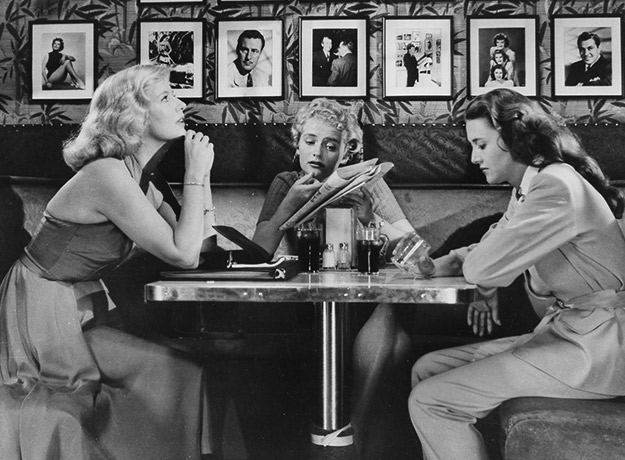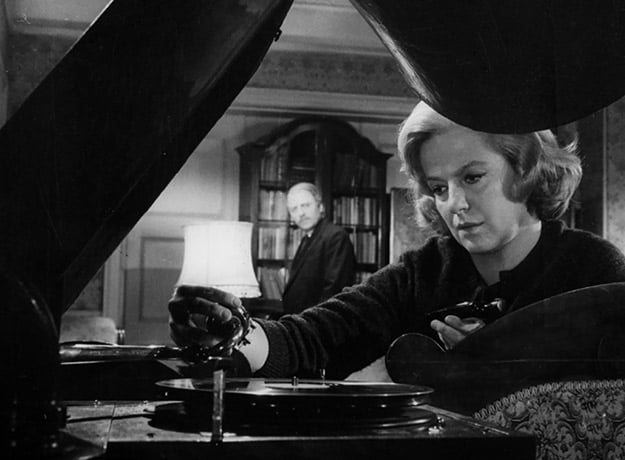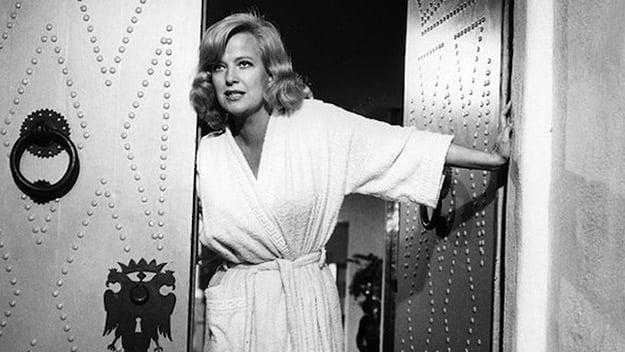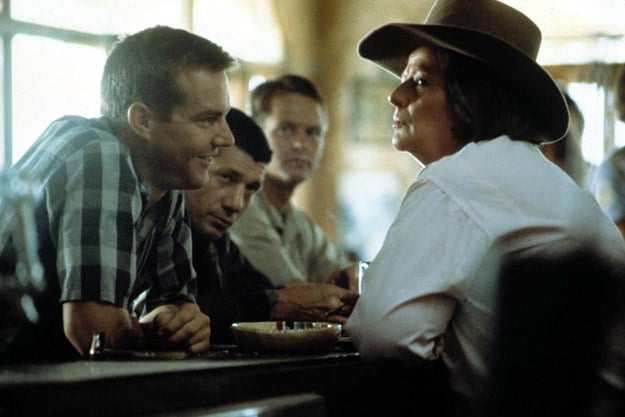TCM Diary: Kim Stanley

The Goddess
One of the saddest things I ever heard was from an acting teacher who reminded us that an acting career is often a tragic pursuit, moving in a circular progression. He described it using Kim Stanley as an example:
1. Who is Kim Stanley?
2. What about Kim Stanley?
3. Get me Kim Stanley.
4. Get me someone like Kim Stanley.
5. Who is Kim Stanley?
Kim Stanley made only four feature films: The Goddess (1958), Seance on a Wet Afternoon (1964, earning her an Academy Award nomination), Frances (1982, another nomination), and The Right Stuff (1983). Her main successes were on the Broadway stage and in 1950s live television. But the legend of her work persists. Listen to how her peers talked about her, or those who saw her in her heyday. Critics used words like “incandescent,” “radiant,” “lit from within.” These are not your garden-variety good reviews. These are the voices of a community realizing that there was a genius in their midst. Peter Hall, who directed Stanley as Maggie in a production of Cat on a Hot Tin Roof, said: “I’ve worked with Olivier, Gielgud, Richardson, Evans, Ashcroft, Sellers, and Charles Laughton. And I have to say she’s one of the greatest actors I worked with of that regal collection.” Paddy Chayefsky, who wrote The Goddess, said: “There’s just one in a generation like her. First Laurette Taylor, now this one.” James Earl Jones appeared with her in the 1960 Broadway production of Taffy and said: “I considered her to be, for women actors, what Marlon Brando was for male actors. She carried that great depth of exploration and dealt with a well of passion and feelings that the character had, just like Marlon did.” The comparison to Brando is so common that Jon Krampner’s 2006 biography of Kim Stanley is called Female Brando.
Stanley became a star in New York playing the teenage Millie in the Broadway production of William Inge’s Picnic, and then originated the role of Cheri in Bus Stop on Broadway, also by Inge. The response to her was explosive. She appeared in many more productions, always causing a stir. Her devotion to the reality of her characters, as well as her ambivalence toward actually getting out there on the stage, made long runs difficult (she was known for dropping out mid-run). Her demons often got the best of her, and she was an alcoholic very young, but that just puts her in the company of many geniuses, those who couldn’t “phone it in” if you paid them a million dollars.

Seance on a Wet Afternoon
Stanley was a towering figure in the vibrant world of 1950s live television, and she gave a couple of performances that brought her critical acclaim and introduced her to a national audience: A Young Lady of Property, Tomorrow (later made into a 1972 film starring Robert Duvall opposite Olga Bellin in Stanley’s role), The Traveling Lady (all three of these written by Horton Foote, who had an extremely fruitful relationship with Stanley). In A Young Lady of Property, the almost-30-year-old Stanley gives a tremendous performance as the adolescent Wilma (with a young Joanne Woodward as sidekick). Over the course of just one hour, Wilma is wrenched from childhood into young womanhood. As an actress, she is often described as “self-indulgent,” a very lazy critique, especially considering the laser-focused quality of much of her work. If you watch A Young Lady of Property, you can see how in charge she is of her performance, its dips and valleys, its heights and peaks. Yes, Stanley was in touch with her emotions, but that is an asset for an actor, not a liability. She also had superb technique, her voice and body able to convey intense emotions with no embarrassment, no hesitation. Watch her ride the waves of Wilma’s experience in A Young Lady of Property. That’s not indulgence: she’s expressing Wilma’s emotions so fully you can feel it through the screen.
One of the great examples of Stanley’s full-bodied full-voiced command of her instrument is in her performance as Big Mama in the 1984 TV movie version of Cat on a Hot Tin Roof—her final role. When Big Mama is finally told the truth about Big Daddy’s condition, Stanley’s head flaps back and forth at first, conveying strong denial, but finally she lets out a howl of agony that comes from such a deep place you want to turn away. Arthur Penn, trying to describe what it was that made her special, put it this way: “Everything was always on the line with Kim.”
While Stanley was never drawn to Hollywood, and didn’t really care for the film-making process, her performance as Emily Ann Faulkner, the small-town-girl turned movie-star in The Goddess, is riveting. The key to the character (inspired by Marilyn Monroe) is that there is a hole inside her that nothing will fill. Stanley works from within that abyss in every moment. In one early scene, she talks to her small-town date for a nonstop breathless 10 minutes. It’s a wall of text: she’s sometimes hopeful, sometimes sad, sometimes putting a bright face on things, and sometimes, sudden rage pierces through. Every switchback makes sense, every impulse comes from somewhere very specific. That scene all by itself is a mini-masterpiece of acting.

The Goddess
One of her greatest performances was in a guest appearance in 1963 on the TV hospital drama Ben Casey. Stanley plays a lawyer with a secret morphine addiction. After collapsing in her office, she finds herself in the hospital, increasingly desperate for a fix. She uses every tactic in the book on her doctor: she berates, flirts, manipulates, begs. Her heart-wrenching cold-turkey withdrawal scenes deserve to be placed in the Pantheon of great Drug Withdrawal moments in film. A young Sidney Pollack was the director, and he films it all with careful and loving attention to her face, highlighting the transparency and fluidity of her emotions. Stanley won an Emmy for her performance.
Stanley continued to be drawn back to New York, to the theater, to the Actors Studio. Yet her personal life was tumultuous, and things began to spiral out of control in the mid-’60s. In 1966, after a famously disastrous performance of the Actors Studio production of The Three Sisters in London (she played Masha), Stanley vowed she would never go on the stage again. She meant what she said. She never did.
Recently, I interviewed Sam Schacht, my teacher from the Actors Studio, who was so inspired by Kim Stanley’s performances in live television when he was a teenager that it’s probably not an exaggeration to say it altered the course of his life. An Actors Studio member, Sam shared a memory with me of being invited by Lee Strasberg to watch a rehearsal of The Three Sisters at The Studio (before it went to London, before it was taped and televised). Sam said, “[The rehearsal] was without sets, and without costumes. There’s a scene at the end when Masha has to say goodbye to Vershinin. Remember, they’re all in their street clothes. Kevin McCarthy was playing Vershinin. And there was a moment when Stanley held onto him and ground her body into his body with a kind of ferocity and desperation which was totally extraordinary. They had to pull them apart. It was a stupendous moment in a dark theater with no set, no costumes, just her genius. It was a million years ago… but I remember that.”

The Right Stuff
James Grissom once interviewed Marlon Brando about Kim Stanley (the entirety is essential reading), and Brando admitted he was asked about her all the time. He said:
“The past is gone, yes, but the past is full of Kim’s brilliance, and I think we—I think you—need to remind people of what they didn’t see and can’t understand. When people ask about Kim, I talk about things that no longer exist, in my opinion: passion, genius, truth, danger, fearless exploration. Maybe someone like Kim wasn’t meant to last long on the stage—it may be too much for most to handle. She was beyond virtually everyone she met, worked with, loved, endured. Many an actor walks—lamely, I might add—in lanes she hacked free, cleared, paved, and then left, and they have not been suitably tended since.”
“An actor is a sculptor who carves in snow.” So said 19th-century actor Edwin Booth (brother to John Wilkes), expressing the truth of actors for millennia before the advent of film. But stories of great performances from the past are passed down, generation to generation, performances we never will get to see. We don’t need to see Sarah Siddons as Lady Macbeth in the 1700s to know she was awe-inspiring. (A century later, Ellen Terry was terrified of tackling the same role because the reputation of Siddons’s version still lingered in the public imagination.) The stories people tell of Eleonora Duse’s involuntary blush onstage in 1895 are legendary, but what is left of her work to see? It melts in our fingers like snow, and we grasp for the sculpture that once was. Laurette Taylor inspired a generation with her performance of Amanda in Tennessee Williams’ Glass Menagerie, a performance never captured on film, lost in the mists of time and yet—similar to Ellen Terry—actresses 70 years later still cower in Taylor’s shadow.
Much of Kim Stanley’s work exists in that ephemeral realm, stage performances that made such a deep impression that 60 years later people can describe the tiniest of moments with intimate detail. Beyond her four feature films and the live television broadcasts that still exist, we have to take the word of those who were lucky enough to be there. Her legacy may very well be that the statement “Get me someone like Kim Stanley” is impossible. She was one of a kind.
The Goddess airs April 7 on Turner Classic Movies.
Sheila O’Malley is a regular film critic for Rogerebert.com and other outlets including The Criterion Collection. She wrote the narration (read by Angelina Jolie) for the Gena Rowlands tribute reel played at the 2016 Governors Awards. Her blog is The Sheila Variations.







